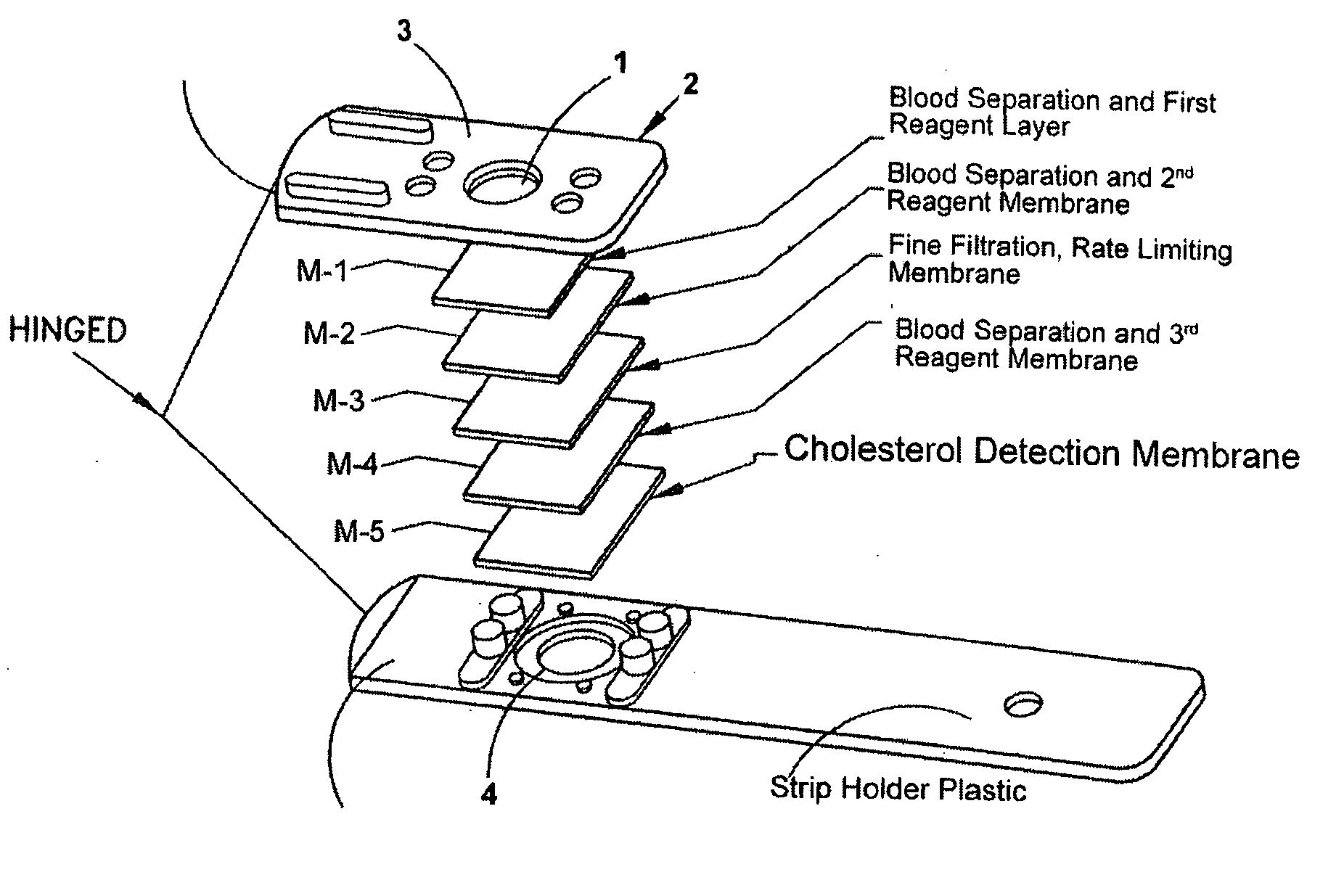Reagent combination and method for direct test strip measurement of cholesterol from low density lipoproteins at ambient temperatures
a low density lipoprotein and ambient temperature technology, applied in the field of in vitro analysis, can solve the problems of inconvenient use, low accuracy, time-consuming, etc., and achieve the effect of facilitating blood spread
- Summary
- Abstract
- Description
- Claims
- Application Information
AI Technical Summary
Benefits of technology
Problems solved by technology
Method used
Image
Examples
example 1
[0037] A dry strip was constructed based on the following membranes and arrangement relative to FIG. 1: [0038] Layer M-1; Tuffglass impregnated as described in “Part A”. [0039] Layer M-2; BTS-300 impregnated as described in “Part B”. [0040] Layer M-3; Supor 1200, untreated [0041] Layer M-4; BTS-300 impregnated as described in “Part B”. [0042] Layer M-5; Biodyne A, as described in the co-pending and commonly assigned U.S. patent application Ser. No. 10 / 663,555, filed Sep. 16, 2003.
[0043] M-1, Tuffglass was dipped in solution “Part A” and was dried with moving air at 38° F.±2.5° C.
Part A
[0044] To 300 mL of laboratory D.I. water the following was added: MES buffer 3.50 g, Sorbitol 9.0 g, sucrose, 9.0 g, polyethylene glycol 200 mwt 7.0 g, dextran sulfate 10K mwt. 10.03 g, NaCl 2.01 g. The pH of the solution was adjusted to a pH of 5.90+ / −0.1 with 5 N NaOH. A total of 2.80 mL of 5 N NaOH was added to give a final pH was 5.85.
[0045] From this stock solution, 169.89 grams were removed ...
example 2
[0048] A dry strip was constructed based on the following membranes and arrangement relative to FIG. 1: [0049] Layer M-1; Tuff Glass impregnated as described in “Part C”. [0050] Layer M-2; Not present. [0051] Layer M-3; Supor 1200, untreated. [0052] Layer M-4; BTS SP300 impregnated as described in “Part D”. [0053] Layer M-5; Biodyne A.
Part C
[0054] The following solution was impregnated onto a depth filter, which can encompass an amorphous fiber or a composite material of either glass, polymer or a random composite matrix. The impregnation can be by any known methods, such as dipping, spraying or freeze drying to produce the top reagent layer of the dry strip.
[0055] To 50 mL of D.I. water the following were added: 1.23 g of MOPS buffer, 1.5 g dextran sulfate with an average molecular weight of 10,000, 0.5 g α-cyclodextrin sulfate, 2.99 g Sorbitol, 3.0 g sucrose, and 0.6 g magnesium chloride, all in 50 ml of D.I. water. The pH was adjusted to 7.17 using 1 ml of 5N NaOH.
Part D
[005...
example 3
[0058] A dry strip was constructed based on the following membranes and arrangement relative to FIG. 1: [0059] Layer M-1; Tuff Glass impregnated as described in “Part E”. [0060] Layer M-2; BTS SP300 impregnated as described in “Part F”. [0061] Layer M-3; Supor 1200, untreated. [0062] Layer M-4; Not present. [0063] Layer M-5; Biodyne A.
Part E
[0064] To 50 mL of D.I. water the following were added: 1.2 g of MOPS buffer, 2.5 g dextran sulfate 10K, 0.5 g alphα-cyclodextrin sulfate, 2.01 g Sorbitol, 2.0 g sucrose, and 0.6 g magnesium chloride. The pH was adjusted to 7.16 using 1 ml of 5N NaOH.
Part F
[0065] To 300 mL of D.I. water, the following reagents were added: 6.19 g Pluronic L121, 3.22 g magnesium chloride, 3.0 g MOPS buffer, 4.0 g alphα-cyclodextrin sulfate, 0.55 g MOPS buffer, 1.1 g Sorbitol, 1.12 g sucrose, 1.88 g Silwet L-77, 1.05 g Pluronic L121. The final pH of the unaltered solution was 7.0. The layer was treated with 60.09 g of this solution.
PUM
| Property | Measurement | Unit |
|---|---|---|
| temperatures | aaaaa | aaaaa |
| pore size | aaaaa | aaaaa |
| pore size | aaaaa | aaaaa |
Abstract
Description
Claims
Application Information
 Login to View More
Login to View More - R&D
- Intellectual Property
- Life Sciences
- Materials
- Tech Scout
- Unparalleled Data Quality
- Higher Quality Content
- 60% Fewer Hallucinations
Browse by: Latest US Patents, China's latest patents, Technical Efficacy Thesaurus, Application Domain, Technology Topic, Popular Technical Reports.
© 2025 PatSnap. All rights reserved.Legal|Privacy policy|Modern Slavery Act Transparency Statement|Sitemap|About US| Contact US: help@patsnap.com



